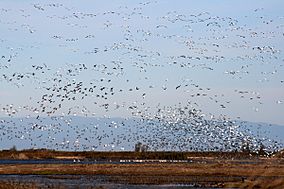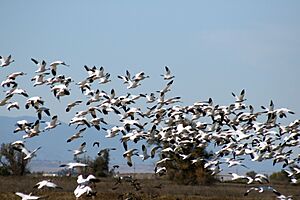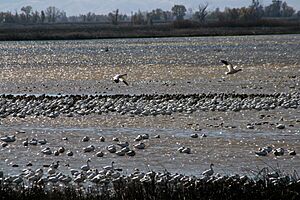Sacramento National Wildlife Refuge Complex facts for kids
Quick facts for kids Sacramento National Wildlife Refuge |
|
|---|---|
|
IUCN Category IV (Habitat/Species Management Area)
|
|

Birds flying at Sacramento National Wildlife Refuge
|
|
| Location | Glenn and Colusa Counties, California, United States |
| Nearest city | Willows, California |
| Area | 10,819 acres (43.78 km2) |
| Established | 1937 |
| Governing body | U.S. Fish and Wildlife Service |
| Website | Sacramento National Wildlife Refuge |
The Sacramento National Wildlife Refuge Complex is a special place in northern California. It's part of a big network of wildlife refuges across the United States. This area is super important for thousands of birds that fly long distances during their migrations.
The refuge was created to help birds that use the Pacific Flyway. This is like a major highway in the sky for birds! Before the refuge, these birds would often land in farm fields, which caused problems for both the birds and the farmers.
The main office and visitor center for the Sacramento National Wildlife Refuge Complex are located within the 10,819-acre Sacramento National Wildlife Refuge. Here, you can find a cool wildlife exhibit, a bookstore, and a Discovery Room. Visitors can also take a six-mile car tour with three viewing spots and two walking trails to see the amazing wildlife.
Contents
History of the Refuge Complex
Before people from Europe settled here in the 1800s, much of the Sacramento River valley was covered in seasonal wetlands and grasslands. These were natural areas that filled with water at certain times of the year.
By the early 1900s, most of these natural wetlands had been turned into farmland. Farmers especially grew a lot of rice. Also, rivers were controlled by levees and irrigation systems, so they no longer created new wetlands naturally. Today, less than 10% of the original wetland area is left.
Even with these changes, migrating birds kept using the area. They would rest in the rice fields and eat a lot of the crops. This caused issues for the farmers.
How the Refuge Was Created
To help solve this problem, the United States Fish and Wildlife Service started creating a refuge in 1937. They got help from the Civilian Conservation Corps, a group that worked on conservation projects. They chose dry, salty lands between the towns of Willows and Maxwell. This became the first Sacramento National Wildlife Refuge.
Since the 1940s, more refuges have been added. Now, the Sacramento National Wildlife Refuge Complex includes several different refuges. They are located about 50 to 90 miles (80 to 145 kilometers) north of the city of Sacramento.
Parts of the Complex
The Sacramento National Wildlife Refuge Complex includes these important areas:
- Sacramento National Wildlife Refuge (near Willows)
- Delevan National Wildlife Refuge (east of Maxwell)
- Colusa National Wildlife Refuge (between Colusa and Williams)
- Sutter National Wildlife Refuge (southwest of Yuba City)
- Sacramento River National Wildlife Refuge (many separate spots along the Sacramento River)
- Butte Sink Wildlife Management Area (northeast of Colusa)
- North Central Valley Wildlife Management Area
- Willow Creek-Lurline Wildlife Management Area
All together, these refuges cover about 34,600 acres (140 square kilometers).
Ecology and Wildlife
The water in the refuge wetlands needs to be carefully managed. People have to control the water flow and even burn some plants to make sure the wetlands stay healthy. This helps provide enough food and resting places for the birds. The different refuges offer various types of homes for wildlife, including:
- Seasonal marshes (wetlands that dry up sometimes)
- Uplands (higher, drier areas)
- Permanent ponds (water all the time)
- Riparian areas (lands along rivers)
Visiting the Refuges
The refuges have places for visitors, but these are limited. This is to make sure the main goal of protecting wildlife isn't disturbed. The wetlands are set up so visitors can get a good view of the birds without bothering them.
There's a visitor center at the Sacramento NWR. You can also take car tours at the Sacramento and Colusa sites. You can only get out of your car at certain spots. Walking trails are available at the Sacramento, Colusa, and Sacramento River sites. In some areas, limited hunting is allowed.
Amazing Animals of the Refuge
Over 300 different kinds of birds and mammals live in or visit the refuges. Not all of them migrate; some live there all year. Here are some of the animals you might see, depending on the time of year:
- Grebes: pied-billed grebe, eared grebe
- Pelicans and Cormorants: American white pelican, double-crested cormorant
- Herons and Egrets: American bittern, great blue heron, great egret, snowy egret, black-crowned night heron, white-faced ibis
- Ducks and Geese: mallard, pintail, American wigeon, cinnamon teal, green-winged teal, bufflehead, northern shoveler, ring-necked duck, wood duck, snow goose, white-fronted goose, Ross's goose
- Raptors (Birds of Prey): turkey vulture, osprey, white-tailed kite, northern harrier, red-tailed hawk, American kestrel, golden eagle, bald eagle (eagles are rare, but you might get lucky!)
- Waders and Shorebirds: ring-necked pheasant, Virginia rail, sora, common moorhen, American coot, killdeer, black-necked stilt, American avocet, greater yellowlegs, western sandpiper, least sandpiper, dunlin, long-billed dowitcher, Wilson's snipe
- Gulls: ring-billed gull, herring gull
- Pigeons and Doves: mourning dove
- Owls: great horned owl, barn owl
- Woodpeckers: Nuttall's woodpecker, northern flicker
- Small Birds (Passerines): western kingbird, yellow-billed magpie, tree swallow, cliff swallow, barn swallow, marsh wren, ruby-crowned kinglet, European starling, American pipit, yellow-rumped warbler, common yellowthroat, Savannah sparrow, song sparrow, Lincoln's sparrow, white-crowned sparrow, golden-crowned sparrow, dark-eyed junco, red-winged blackbird, western meadowlark, Brewer's blackbird, brown-headed cowbird, Bullock's oriole, house finch, house sparrow
- Mammals: black-tailed jackrabbit, California ground squirrel, black-tailed deer
Plants of the Refuge
Even though many of the original wetlands are gone, the Sacramento National Wildlife Refuge Complex still has a wide variety of plants. Among the beautiful wildflowers you can find is the yellow mariposa lily, known scientifically as Calochortus luteus.



